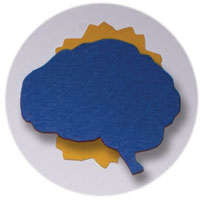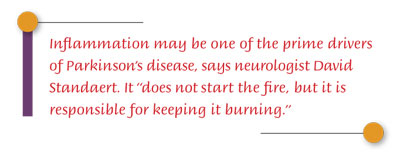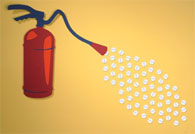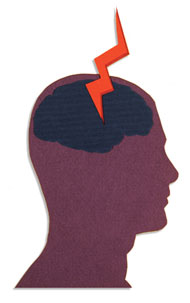Protecting the Brain with Anti-Inflammatory Medications

COULD AN IBUPROFEN A DAY keep Alzheimer’s and Parkinson’s at bay? As researchers continue to uncover evidence of inflammation’s crucial role in neurodegenerative diseases, they are hoping to discover new ways to attack these devastating conditions. “One of the issues our laboratory has been working on for the last couple of years is the idea that inflammation may be one of the prime drivers of Parkinson’s disease,” says David G. Standaert, M.D., Ph.D., John and Juanelle Strain Professor and interim chair of the Department of Neurology at UAB and director of the Center for Neurodegeneration and Experimental Therapeutics. “The idea that we are working on is that the initial ‘trigger’ for Parkinson’s is related to abnormal proteins in the brain, oxidative stress, and other factors—but once the injury to the brain starts, it is neuroinflammation which is responsible for the progression. Inflammation does not start the fire, but it is responsible for keeping it burning.” Data reported this March in the journal Neurology provided new evidence that long-term use of non-steroidal anti-inflammatory drugs (NSAIDs) may protect the brain against disease. In the study, people who took ibuprofen two or more times per week were 38 percent less likely to develop Parkinson’s disease than those who didn’t. These results join several earlier studies as evidence that “some non-steroidal anti-inflammatory drugs may have a neuroprotective effect in Parkinson's disease,” says Standaert. A Matter of TimingMore than 20 years ago, researchers noticed that people with chronic inflammatory diseases such as rheumatoid arthritis had a lower risk of Alzheimer’s disease, says David S. Geldmacher, M.D., Charles and Patsy Collat Scholar and professor of neurology at UAB. “The theory was that these people were protected because they took anti-inflammatory medications for such a long period of time.” That discovery led to many clinical trials to see if the results could be replicated in patients who already showed signs of Alzheimer’s. Unfortunately, “none have shown a positive effect so far,” Geldmacher notes. This could be because the effect of anti-inflammatory drugs is small but cumulative: “If you only have a 1 percent-per-year protection, that may be too small to detect in clinical trials, but it can add up over 20 years,” Geldmacher notes. A second theory is that “prevention requires one set of medicines, but treatment requires another set entirely.” |
|
|
|
As in many other areas of inflammation research, the exact mechanisms in play in Alzheimer’s disease are still an “open question,” Geldmacher says. A leading theory proposes that the accumulation of amyloid proteins in the Alzheimer’s brain triggers an inflammatory reaction led by microglia. These key foot soldiers of the central nervous system, the theory goes, seek and destroy both the amyloid proteins and surrounding, healthy neurons, leading to the progressive degenerative symptoms characteristic of Alzheimer’s. Geldmacher, who recently arrived at UAB from the University of Virginia, is building on his research at that institution to study new therapies to treat Alzheimer’s, including a drug called pioglitazone that was originally designed to treat diabetes. Diagnosing DepressionClumps of proteins aren’t the only cause of chronic inflammation in the brain, notes Richard S. Jope, Ph.D., a professor in the Department of Psychiatry. “In the past two to three years, inflammation has been recognized as an important component of depression,” Jope says. The common link seems to be stress. “Psychological stress is known to activate the inflammatory response,” Jope says. “This typically resolves in a few hours, but in people susceptible to depression it doesn’t and they can get all the symptoms of chronic inflammation.” This inflammation can in turn impair therapy by interfering with the action of antidepressant medications, Jope says. “It’s possible that reducing inflammation in combination with antidepressants may be better than using antidepressants alone.”
These investigations are still in the early stages, Jope points out, as researchers try to identify the specific targets that control neuroinflammation. Jope’s lab is investigating the anti-inflammatory properties of lithium, a drug commonly prescribed for bipolar disorder. “The enzyme that lithium inhibits is an enzyme that drives inflammation,” he says. “So we’re trying to see if an important part of lithium’s therapeutic effect may in fact be its anti-inflammatory properties. If that’s the case, then there are other drugs that may inhibit the enzyme better than lithium, at lower concentrations and hopefully with fewer side effects.” Jope is working with several immunology researchers at UAB, including Eleonore Beurel, Ph.D., Laurie E. Herrington, Ph.D., and Suzanne Michalek, Ph.D. “We need a lot of collaboration because the immune system has a lot of interacting pathways,” Jope says. “Testing all of them is a big job.” Jope’s group is also collaborating with neurologist John Rinker, Ph.D., who is seeking to evaluate lithium’s potential benefits for patients with multiple sclerosis. Splitting Headache
It turns out that migraine “is a disorder that, as with primary epilepsy, reflects a genetically ‘hypersensitive’ brain,” Rothrock says. He notes that researchers at Harvard recently reported evidence indicating that electrical events originating in the brain itself may provoke activation of the receptors for head pain that are located “downstream,” within the meninges that cover the brain. “It appears that a migraine attack may originate within the visual cortex of the brain,” he continues, “with activity generated at that site serving to cause the trigeminal nerve to release certain neuropeptides that in turn induce meningeal blood vessels to leak pro-inflammatory proteins, which activate and further sensitize the head pain receptors, sending a message back to the brain that ‘there’s pain out here.’” Neuroinflammation “has been a big player in migraine research for about 15 years,” Rothrock says, “but that’s not to say that we’ve been very good at treating this inflammation.” Noting that obesity correlates with both migraine severity and biomarkers of systemic inflammation, Rothrock and his UAB colleagues are investigating whether the three may be interrelated and—of potentially high clinical relevance—whether weight loss may promote a reduction in inflammation paralleled by a reduction in headache burden. [Learn more about Botox treatment for chronic migraine at UAB.]
|
 Geldmacher offers an analogy to heart care, where statins offer significant preventive effects but are no help when a patient is actually having a heart attack—“in that case, you would want to give a clotbusting drug. Things that work in prevention may not work in treatment, and vice versa.”
Geldmacher offers an analogy to heart care, where statins offer significant preventive effects but are no help when a patient is actually having a heart attack—“in that case, you would want to give a clotbusting drug. Things that work in prevention may not work in treatment, and vice versa.”
 Unlike most neurodegenerative diseases, the cause of migraine had been understood for years—or so scientists thought, says UAB neurologist John F. Rothrock, M.D., an internationally renowned migraine researcher and director of the
Unlike most neurodegenerative diseases, the cause of migraine had been understood for years—or so scientists thought, says UAB neurologist John F. Rothrock, M.D., an internationally renowned migraine researcher and director of the